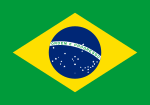Brazilian diaspora
 |
|
| Total population | |
|---|---|
| 1.5 to 2 million | |
| Regions with significant populations | |
|
|
1,100,000 |
|
|
210,032 |
|
|
201,527 |
|
|
140,426 |
|
|
128,238 |
|
|
118,000 |
|
|
95,000 |
|
|
85,000 |
|
|
80,000 |
|
|
44,000 |
|
|
43,000 |
|
|
31,000 |
|
|
27,135 |
|
|
27,100 |
|
|
26,482 |
|
|
22,920 |
|
|
22,000 |
|
|
10,710 |
|
|
10,649 |
|
|
10,040 |
|
|
8,704 |
|
|
5,000 |
|
|
800 |
| Languages | |
| Primarily Portuguese (99%) Indigenous languages (0.082%) German (Hunsrückisch, Pomeranian and Plautdietsch) (1.94%) and language(s) of country of residence |
|
| Religion | |
| Predominantly Roman Catholic (64%) Protestantism (22%) No religious affiliation (9%) Spiritism (1.3%) Buddhism and Shinto derived Japanese new religions (1%) Judaism (0.5%) Afro-Brazilian religions (0.1%) Islam (0.017%) |
|
| Related ethnic groups | |
| Brazilian people | |
The Brazilian diaspora comprises Brazilians who have migrated to other countries, a fairly recent phenomenon that has been driven mainly by economic problems that afflicted Brazil from the ending of the military dictatorship in the 1980s to the early 2000s (decade).
There are an estimated 1.5 million Brazilians living abroad, mainly in the U.S. (450,599), Japan (~210,000), Paraguay (201,527), Portugal (~120.000), Spain (~120.000), Germany (~100.000), United Kingdom (100,000) France (80,000), Italy (35,000), Switzerland (25,000), Angola (30,000), and another 100,000 are living in other European countries.
There were an estimated 246,000 Brazilian Americans as of 2007. Another source gives an estimate of some 800,000 Brazilians living in the U.S. in 2000, while still another estimates that as of 2008[update] some 1,100,000 Brazilians live in the United States, 300,000 of them in Florida. Major concentrations are in New York, Massachusetts, New Jersey, Connecticut, Georgia, Florida and California.
West 46th Street has historically been a commercial center for Brazilians living or visiting New York City. In 1995 the city officially recognized it as "Little Brazil Street".
In Massachusetts, there is a very significant concentration of Brazilian immigrants in the town of Framingham, which in recent years has spilled out into the neighboring towns of Marlborough and Hudson, among others. In the Brazilian community is said that the already mentioned town of Framingham, MA along with Pompano Beach in Florida have both, the greatest concentration of Brazilians in the USA. The Brazilian communities in these towns are vibrant, having contributed much to the local cuisine and culture, but Brazilian immigrants often feel discriminated against and are often thought to be illegal immigrants by their non-Brazilian neighbors.
...
Wikipedia
